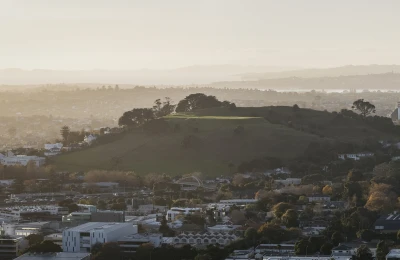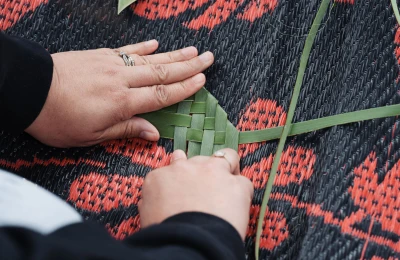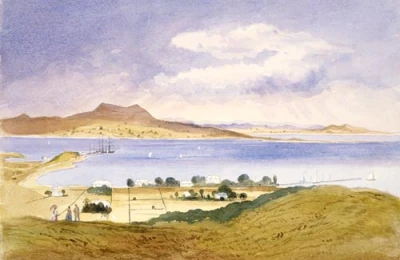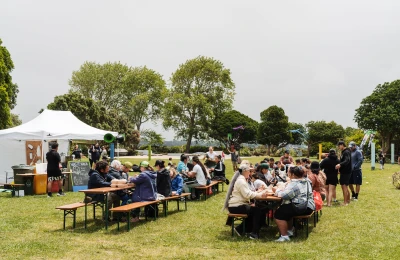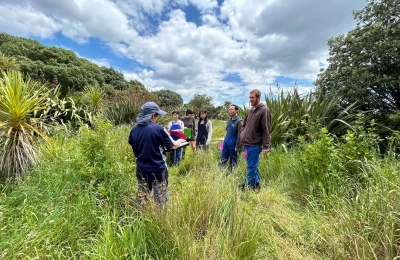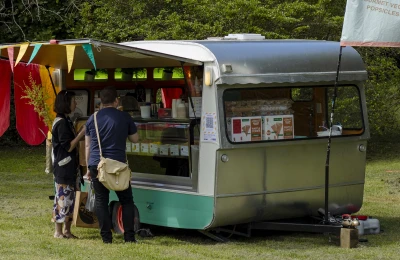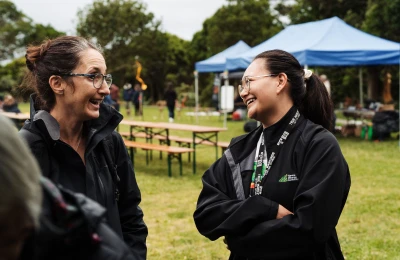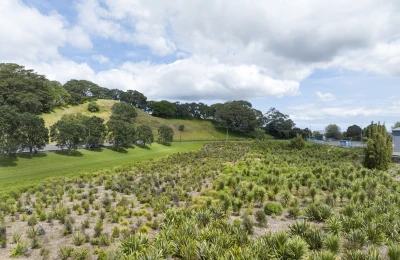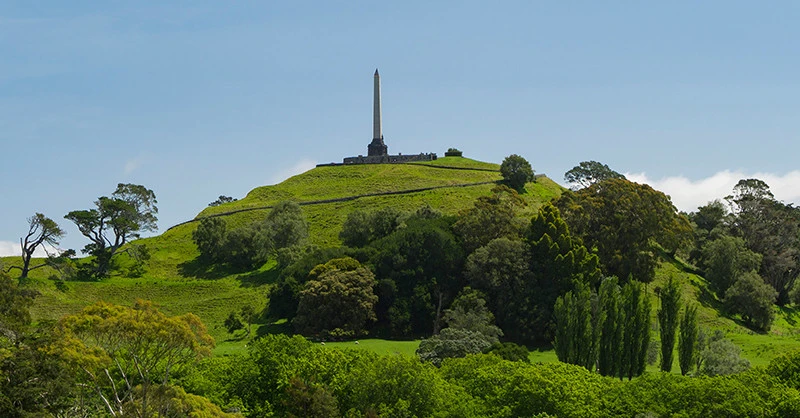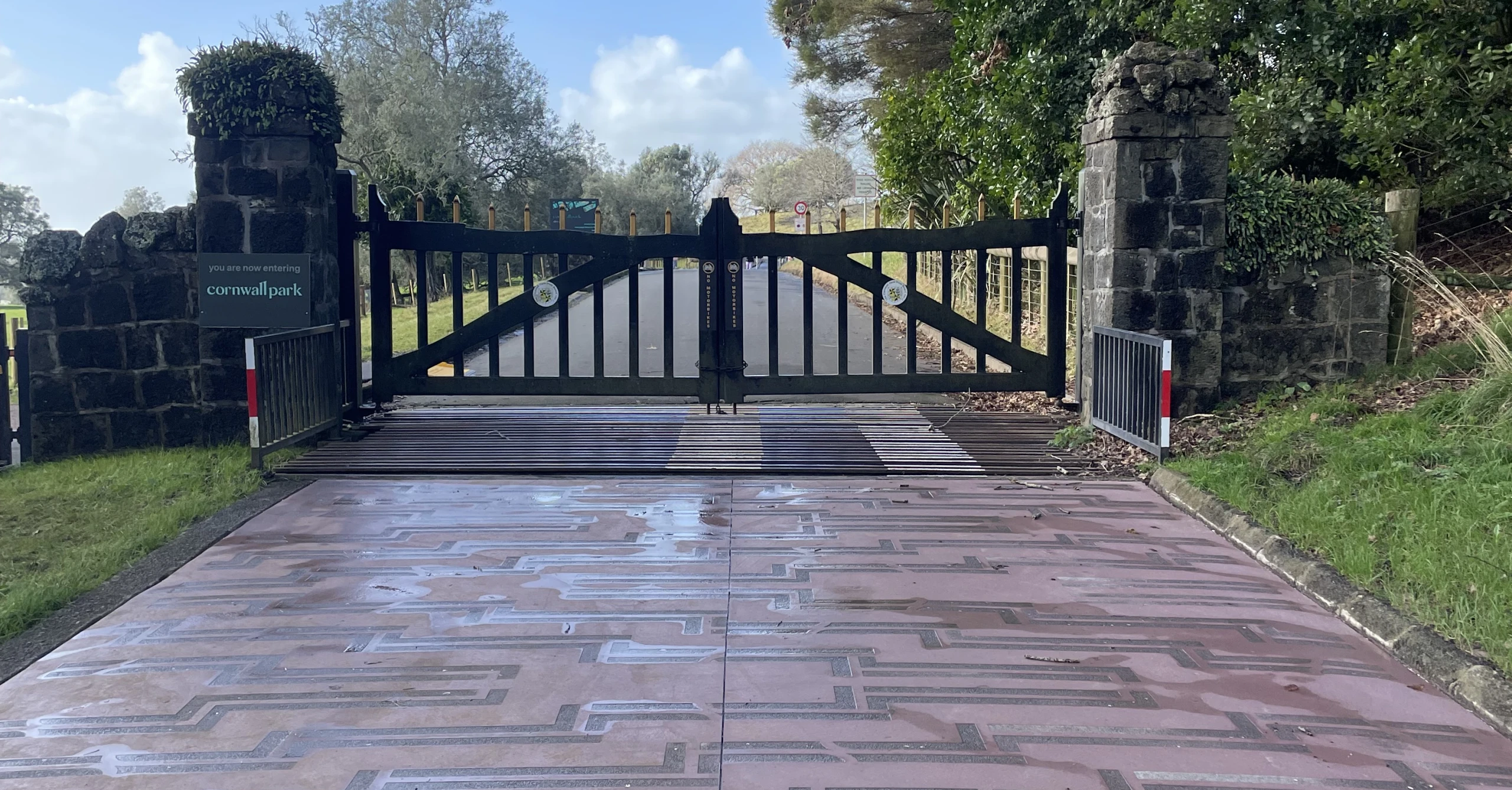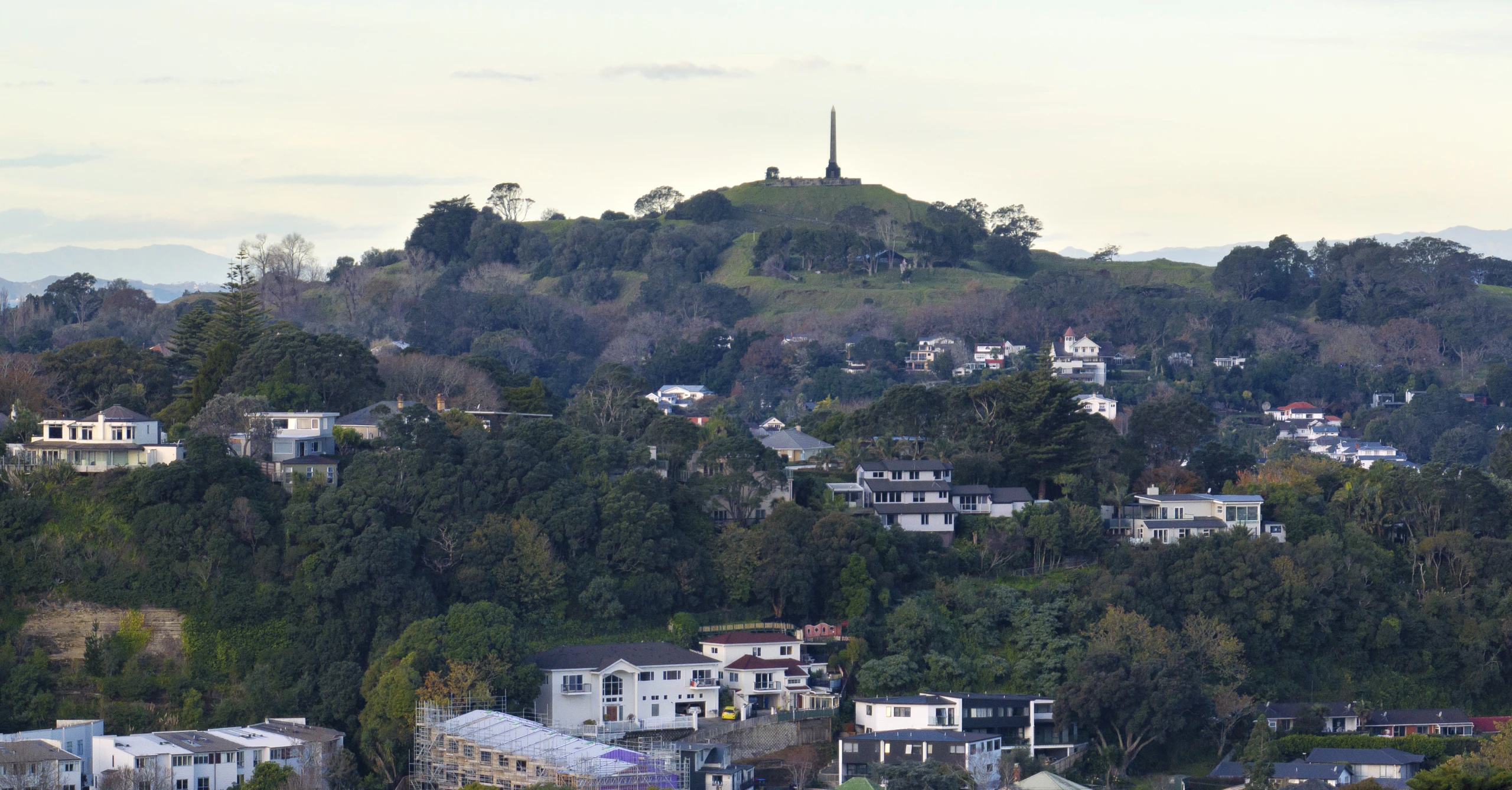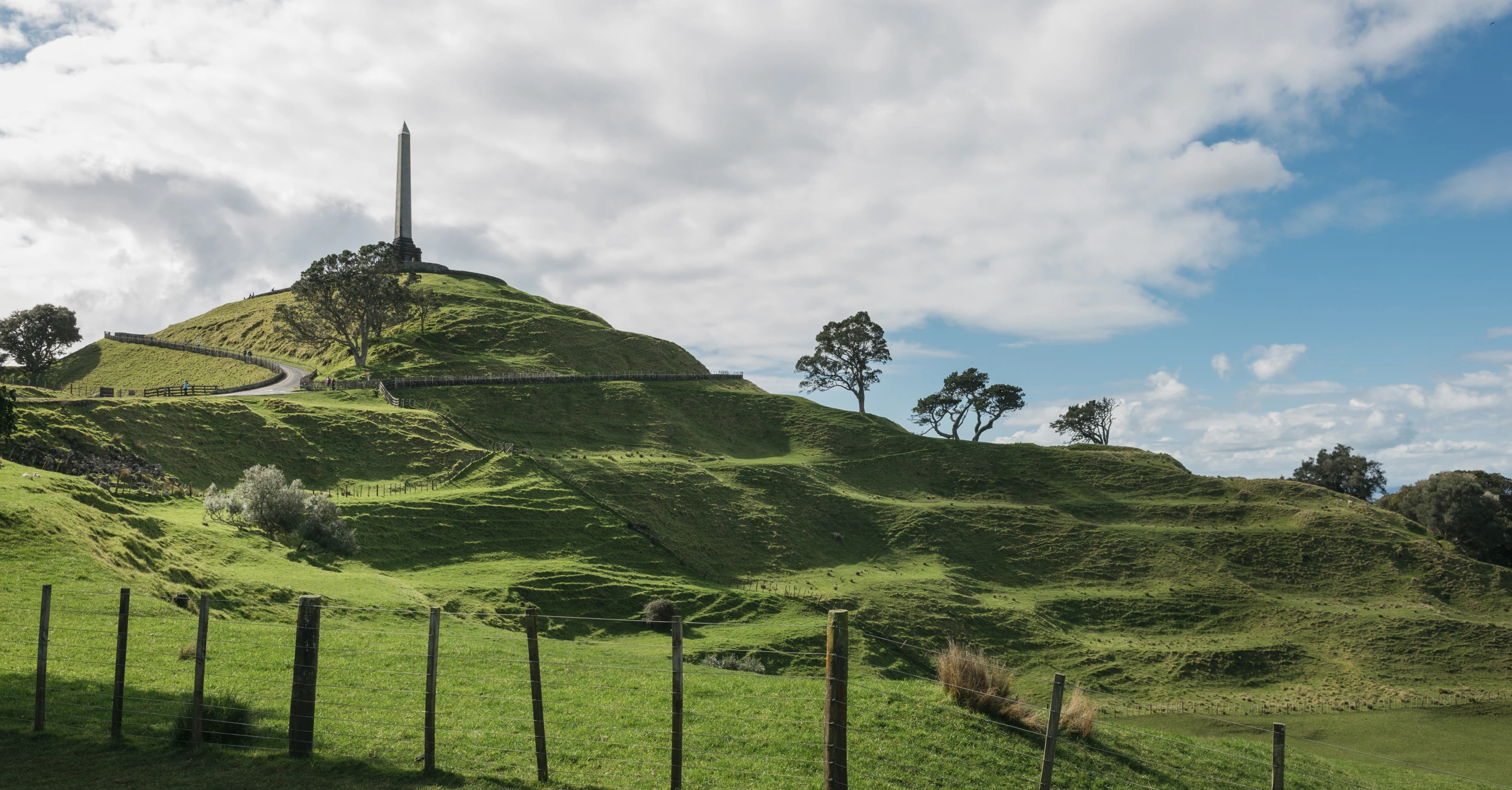PĀ
Maungakiekie is the most extensively developed Māori pā (village settlement) in Tāmaki Makaurau / Auckland and one of the largest pre-European archaeological site complexes in New Zealand. It is also one of the largest pre-iron-age forts in the world.
At the height of its occupation it was home to thousands of people. Its four tihi (summits) were all heavily defended by ditches and wooden palisades. On its peak was the ‘tihi’, the most sacred and heavily defended part of the complex and the flanks were extensive (terraces) for whare moe (sleeping houses), rua (roofed storage pits) for seasonal storage of kūmara and other crops, tāpapa (garden mounds) and hāngī (earth oven) pits.
The terraces and pits exist today as the last remaining remnants of this historic monumental fortress. These important archaeological features are highly sensitive to erosion and visitors must not walk on or through them.
Maungakiekie means “the hill of the kiekie vine”, which once grew abundantly on this Maunga.
GEOLOGY
Maungakiekie is one of the oldest volcanos in the Auckland volcanic field and the second-largest with 20 square kilometers of lava flow fields surrounding a large, complex scoria cone.
The age of the Maunga is not precisely known but it is older than 28,500 years old, as it is blanketed with up to 3 metres of ash blown over from Te Tātua a Riukiuta / Big King, 2 kilometers away. This cap of orange-brown bedded ash can be seen in the old quarry on the southern slope of Maungakiekie.
The tihi (summit) of the Maunga stands at 184 meters above sea level and is made of scoria that fountained explosively out of the adjacent crater. Two craters in the southwest and southeast of the Maunga are horseshoe shaped, having been breached by lava flows that carried away the scoria ramparts on their downhill sides.
Lava bursting through the northern lower flanks of the main peak resulted in lava flows that spread broadly out and completely surrounded the volcano. To the north the flows may have reached Khyber Pass Rd in Newmarket.
TIHI TREES
Maungakiekie has a history of notable trees on its tihi (summit). One historic name for the tihi is Te Tōtara I Ahua after the sacred lone tōtara that grew there until it was felled by Pakeha vandals in 1852. The name One Tree Hill also stems from this lone tōtara tree.
In the 1860s John Logan Campbell began tree planting, including a grove of several Monterey Pine trees on the tihi. The grove eventually became a single Monterey Pine which most people in recent times associate as the one tree of One Tree Hill. The pine was first vandalised in 1994 and then again 1999. The tree was completely removed in 2000 as it had become unsafe.
In June 2016, during a dawn planting ceremony attended by hundreds of Aucklanders, the Tūpuna Maunga Authority returned native trees to the tihi, planting a grove of three tōtara and six pohutukawa on the same spot as the previous Monterey Pine tree. The intention is that a single tree will ultimately remain when it is able to survive on its own.
OBELISK
Sir John Logan Campbell died in 1912 and is buried on the tihi of Maungakiekie. The 21-metre obelisk also on the tihi was bequeathed by him as a memorial to the Māori people. It is made of basalt and Coromandel Granite and was finally completed in 1948 and unveiled by the Māori King, Koroki.
VEHICLE-FREE SUMMIT
To recognise the cultural, historic and archaeological significance of the Maunga, the summit road and the tihi (summit) at Maungakiekie / One Tree Hill was permanently closed to private motor vehicles, including motorbikes and scooters, in May 2018.
CORNWALL PARK BOUNDARY
The Maunga of Maungakiekie and western part of the reserve extending to Manukau Road and encompassing the Stardome Observatory and Sorrento function centre is part of the Treaty of Waitangi redress and is managed by the Tūpuna Maunga Authority.
Abutting the Maunga is Cornwall Park which is managed separately by the Cornwall Park Trust.
PARKING
Parking is available at the start of the summit road and parking time limits are enforced to give all visitors equal parking opportunity.
AUTOMATIC GATE OPENING HOURS
Summer: 7 am – 8.30 pm
Winter: 7 am – 7pm.
Times align to Daylight Savings.
The gate will automatically open for any cars inside the Maunga and will not require a code when exiting.
Gate opening and closing times will be subject to change with events running at the Stardome and Sorrento.
TIHI (SUMMIT) ROAD GATE OPENING HOURS
- Summer: 7 am – 8.30 pm
- Winter: 7 am – 7 pm
Times align with daylight savings.
DOG RULES
Under control ON leash.
No dogs allowed in the playground area.
Please make sure to pick up after your dogs and dispose of waste in rubbish bins.
LOCATION
670 Manukau Road, Epsom, Auckland
PĀ
Maungakiekie is the most extensively developed Māori pā (village settlement) in Tāmaki Makaurau / Auckland and one of the largest pre-European archaeological site complexes in New Zealand. It is also one of the largest pre-iron-age forts in the world.
At the height of its occupation it was home to thousands of people. Its four tihi (summits) were all heavily defended by ditches and wooden palisades. On its peak was the ‘tihi’, the most sacred and heavily defended part of the complex and the flanks were extensive (terraces) for whare moe (sleeping houses), rua (roofed storage pits) for seasonal storage of kūmara and other crops, tāpapa (garden mounds) and hāngī (earth oven) pits.
The terraces and pits exist today as the last remaining remnants of this historic monumental fortress. These important archaeological features are highly sensitive to erosion and visitors must not walk on or through them.
Maungakiekie means “the hill of the kiekie vine”, which once grew abundantly on this Maunga.
GEOLOGY
Maungakiekie is one of the oldest volcanos in the Auckland volcanic field and the second-largest with 20 square kilometers of lava flow fields surrounding a large, complex scoria cone.
The age of the Maunga is not precisely known but it is older than 28,500 years old, as it is blanketed with up to 3 metres of ash blown over from Te Tātua a Riukiuta / Big King, 2 kilometers away. This cap of orange-brown bedded ash can be seen in the old quarry on the southern slope of Maungakiekie.
The tihi (summit) of the Maunga stands at 184 meters above sea level and is made of scoria that fountained explosively out of the adjacent crater. Two craters in the southwest and southeast of the Maunga are horseshoe shaped, having been breached by lava flows that carried away the scoria ramparts on their downhill sides.
Lava bursting through the northern lower flanks of the main peak resulted in lava flows that spread broadly out and completely surrounded the volcano. To the north the flows may have reached Khyber Pass Rd in Newmarket.
TIHI TREES
Maungakiekie has a history of notable trees on its tihi (summit). One historic name for the tihi is Te Tōtara I Ahua after the sacred lone tōtara that grew there until it was felled by Pakeha vandals in 1852. The name One Tree Hill also stems from this lone tōtara tree.
In the 1860s John Logan Campbell began tree planting, including a grove of several Monterey Pine trees on the tihi. The grove eventually became a single Monterey Pine which most people in recent times associate as the one tree of One Tree Hill. The pine was first vandalised in 1994 and then again 1999. The tree was completely removed in 2000 as it had become unsafe.
In June 2016, during a dawn planting ceremony attended by hundreds of Aucklanders, the Tūpuna Maunga Authority returned native trees to the tihi, planting a grove of three tōtara and six pohutukawa on the same spot as the previous Monterey Pine tree. The intention is that a single tree will ultimately remain when it is able to survive on its own.
OBELISK
Sir John Logan Campbell died in 1912 and is buried on the tihi of Maungakiekie. The 21-metre obelisk also on the tihi was bequeathed by him as a memorial to the Māori people. It is made of basalt and Coromandel Granite and was finally completed in 1948 and unveiled by the Māori King, Koroki.
VEHICLE-FREE SUMMIT
To recognise the cultural, historic and archaeological significance of the Maunga, the summit road and the tihi (summit) at Maungakiekie / One Tree Hill was permanently closed to private motor vehicles, including motorbikes and scooters, in May 2018.
CORNWALL PARK BOUNDARY
The Maunga of Maungakiekie and western part of the reserve extending to Manukau Road and encompassing the Stardome Observatory and Sorrento function centre is part of the Treaty of Waitangi redress and is managed by the Tūpuna Maunga Authority.
Abutting the Maunga is Cornwall Park which is managed separately by the Cornwall Park Trust.
NEW TRACK UPGRADES JANUARY 2025
The Tūpuna Maunga Authority will be undertaking track improvements at Maungakiekie / One Tree Hill, starting approximately mid- January 2025. These improvements include formalising an informal track towards the tihi (summit). This will include building new boxed steps and adding aggregate tracks along this walkway. The boxed steps will be built to protect further erosion of the Maunga and walkways into sensitive archaeological features.
These improvements are designed to enhance the experience for all manuhiri (visitors).
Construction dates
Work is scheduled to begin in mid-January 2025 and will take approximately 20 – 22 weeks to complete. Construction will be Monday to Friday (and Saturday morning, where required) during work hours to limit disturbance to neighbours. Please note there could be delays due to weather or other unforeseen circumstances. The primary establishment site for the construction team will be set up on the Cornwall Park Trust site (near Olive grove) to store materials and access for machinery. Part of the carpark at the tihi will be used for material storage during the upgrade.
Visitor access
Pedestrian, cycle, and vehicle access will be maintained throughout the upgrade works. Alternative routes to the tihi can be accessed from Western Crater carpark pedestrian track and will be signposted.
Health and Safety
The health the safety of the Maunga, our manuhiri and residents are a priority. Please follow the instructions of onsite staff and the temporary signage in place. Our construction team are working hard to create a better, safer experience for all, please be kind.
PARKING
Parking is available at the start of the summit road and parking time limits are enforced to give all visitors equal parking opportunity.
AUTOMATIC GATE OPENING HOURS
Summer: 7am-8.30pm
Winter: 7am-7pm.
Times align to Daylight Savings.
The gate will automatically open for any cars inside the Maunga and will not require a code when exiting.
Gate opening and closing times will be subject to change with events running at the Stardome and Sorrento.
TIHI (SUMMIT) ROAD GATE OPENING HOURS
- Summer: 7am-8.30pm
- Winter: 7am-7pm
Times align with daylight savings.
DOG RULES
Under control ON leash.
No dogs allowed in the playground area.
Please make sure to pick up after your dogs and dispose of waste in rubbish bins.
LOCATION
670 Manukau Road, Epsom, Auckland
